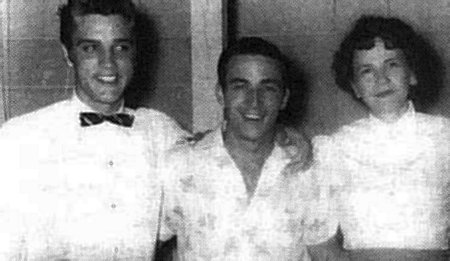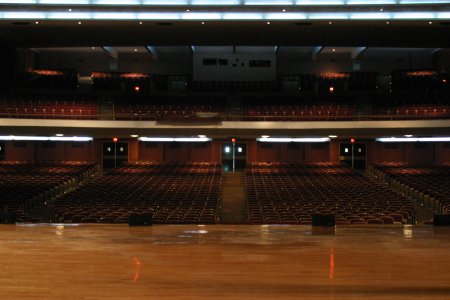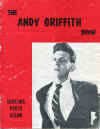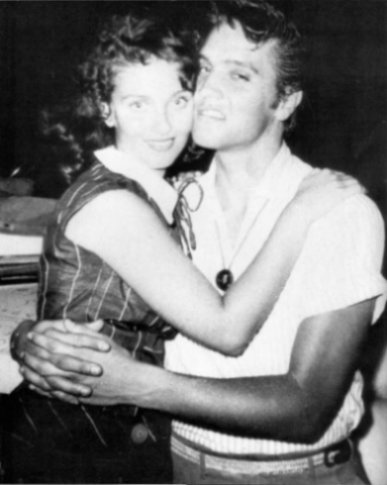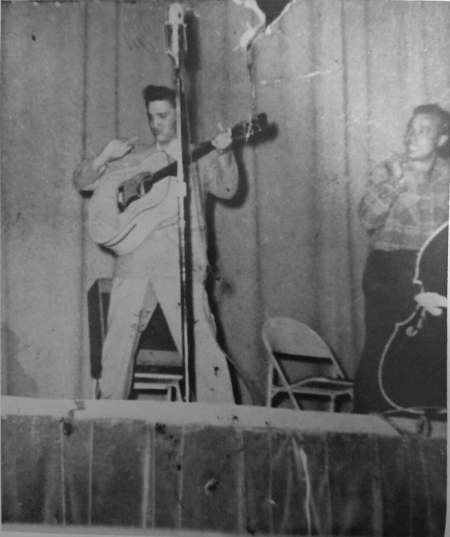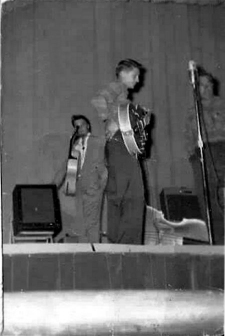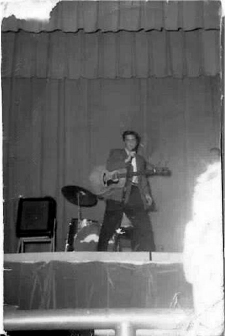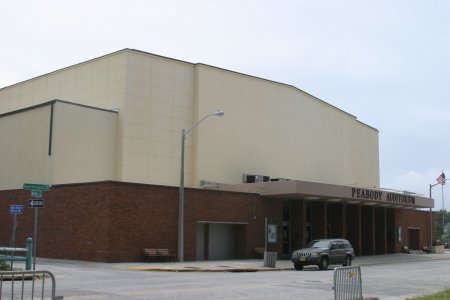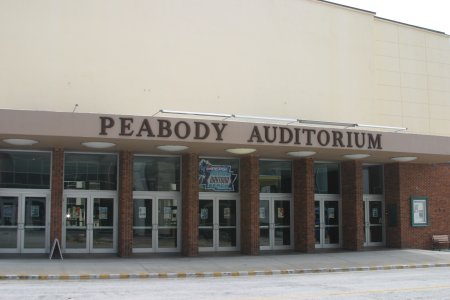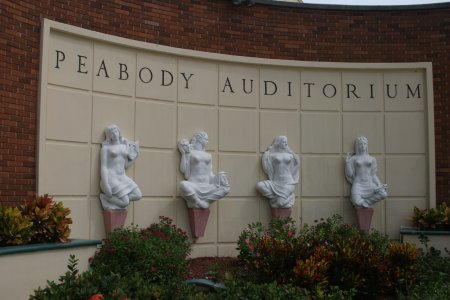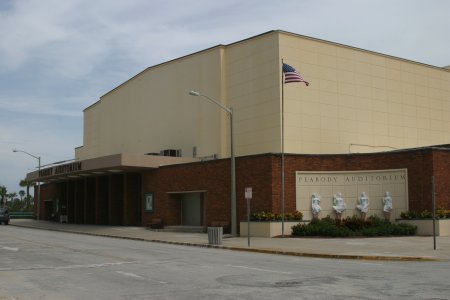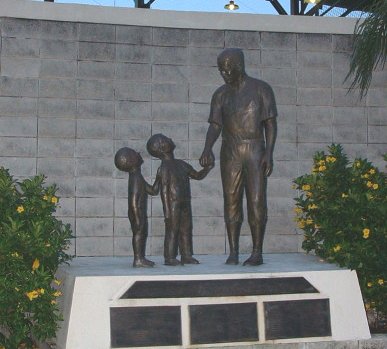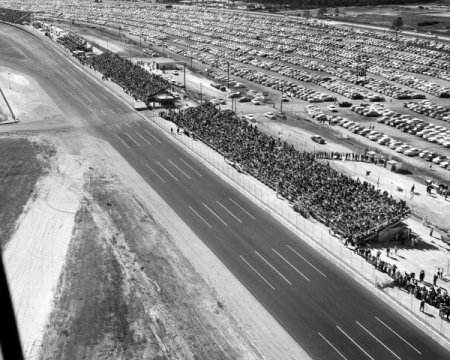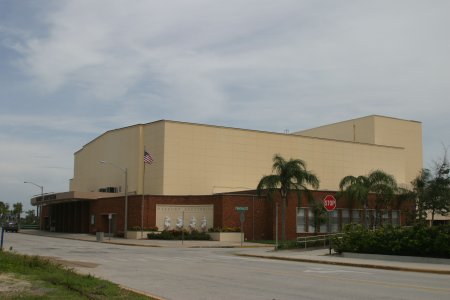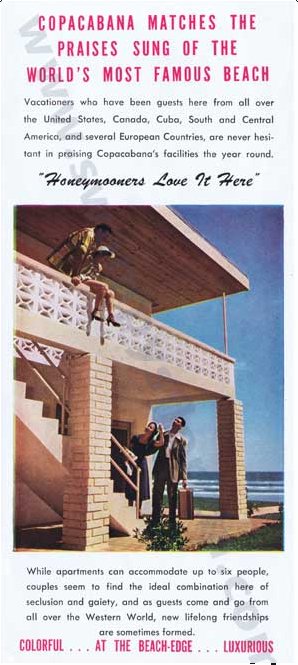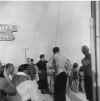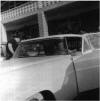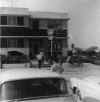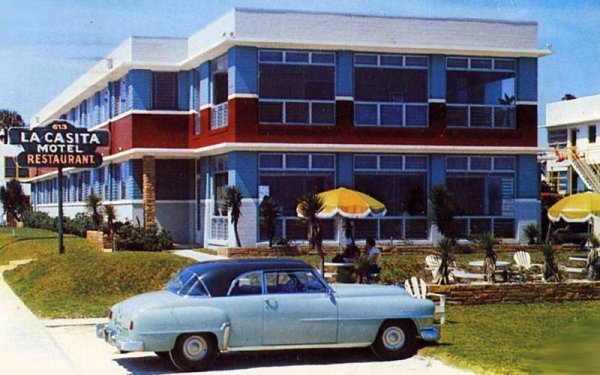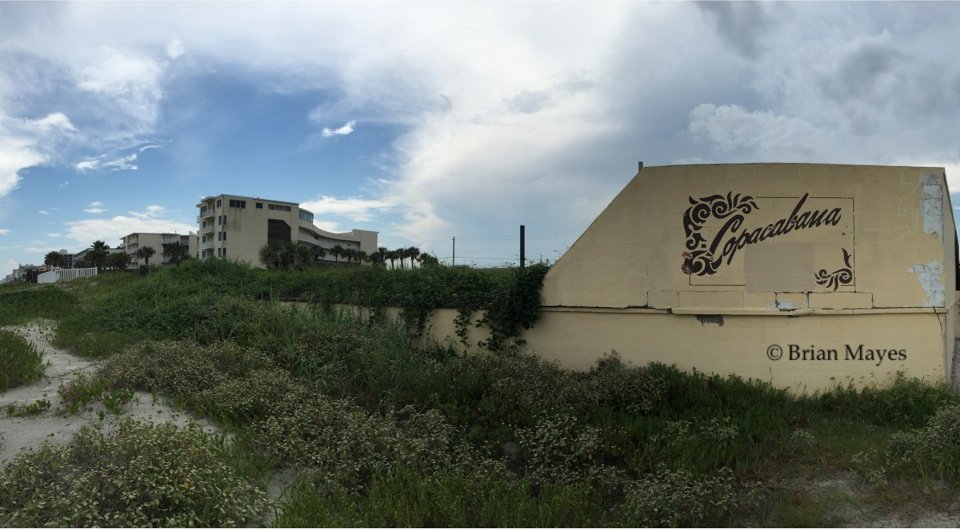 |
The Peabody Auditorium
By the time the original auditorium in Daytona was built in the 1920s, the city was already known for its beaches, wildlife and racing. "The hard-packed sand of the beaches provided the perfect setting for people to test just how fast these new automobiles could go. In 1907, just 11 years after Henry Ford built the first automobile with a top speed of 20 mph, Fred Marriott set a land-speed record crashing his car at 197 mph. Amazingly, he was not injured. Yet, it was a young Englishman by the name of Malcolm Campbell who came to characterize Daytona racing. In his car, the Bluebird, Campbell broke the land-speed record four times. In his final race in Daytona in 1935, Campbell reached 277 mph."1
In 1945 the original auditorium was destroyed in a fire but prior to that had hosted a famous evangelist, a renowned pianist and John Philip Sousa and his marching band among other events. In 1948, construction began rebuilding the 2560 seat auditorium. The new auditorium, named in honor of benefactor Simon J. Peabody, was dedicated on October 6, 1949, with a concert featuring the U.S. Navy Band.2 It was built in an all white section on the peninsula side of the Halifax river for $808,000.00 from proceeds of a general obligation bond issue that was retired with both tax revenue and a 6 percent rebate from the Florida Power and Light Company, hence, public funds.3
Strangely enough, Daytona Beach was the first Florida city to let Jackie Robinson play ball during the 1946 season's Spring Training. The Triple-A Montreal Royals, which Robinson was playing for, was in-state to play an exhibition against their parent club, the Brooklyn Dodgers. Both Jacksonville and Sanford refused to let the game go on due to segregation laws. Daytona Beach was the first to permit the game to be played, and it was played on March 17, 1946. This led to his ultimately breaking the color line in 1947, the year he joined the Dodgers. The refusal by Jacksonville in particular, previously the Dodgers' spring training home, led the Dodgers to host Spring Training at the Daytona park in 1947.4
Peabody auditorium, however, admitted whites only until 1952. On June 5, 1952, in a suit brought by a group more than two years earlier contending that "the Peabody color line deprived them of rights guaranteed under the 14th Amendment to the Constitution," the Federal District Court in Jacksonville ruled that since the auditorium was built with public funds, "Negroes must be permitted to attend performances open to the public in the Daytona Beach Peabody Auditorium."3
She hooked up with the Colonel in 1955 on a Hank Snow tour and began doing advance press work for him in the Jacksonville-Orlando-Daytona area. As a woman who was both attractive and feisty, Mae claimed to be the only person that she knew ever to get an apology out of the Colonel. Ordinarily, his one response to any form of criticism was "The Colonel is the boss." 5
“You be the boss," she said angrily when he tried this line on her. "Be the big wheel. But don't ever ask me to do another thing for you." Which led to the apology. Despite this incident, or perhaps because of it, she always got along well with the Colonel and for a time even served as Hank Snow’s personal publicist. She was energetic and resourceful and proved an excellent local PR woman on a management team that left nothing to chance. 5 Mae would later co-write "Heartbreak Hotel" with Tommy Durden which would be Elvis' first recording with RCA and ultimately his first Gold record.
Elvis' popularity with the crowds over the headliners of that tour was apparent from the start. Though not in Daytona, Faron Young also played dates on that tour. Gary Corsair of The Villages Sun would later write, “Just about everybody on that show would put him down. I know he could hear it,” recalled Faron Young’s fiddle player Gordon Terry in Live Fast, Love Hard: The Faron Young Story (University of Illinois Press). According to Young’s biographer Diane Diekman, when Terry invited Elvis to swim at the motel where the headliners were staying, Young and the others got out of the pool and returned to their rooms.6
The band also performed at the Peabody on July 30, 1955 during their next tour of Florida as a supporting act for headliners such as Andy Griffith, Marty Robbins and Ferlin Husky. Their last performance at the Peabody was on August 9, 1956 while on a ten day tour of Florida and New Orleans which would be the last before Elvis left for Hollywood and the movies. By this time they had been on National Television, Elvis was an established star and they weren't opening for anyone.
According to Brian Petersen in "The Atomic Powered Singer", quoting from Daytona newspapers at the time, Elvis was scheduled for one show on August 9 but due to the popular demand for tickets they had to add a second appearance. The police had been alerted for any possible riots. Patrolmen were stationed backstage and out front to avoid any trouble from the fans. The two shows at the Peabody Auditorium brought in the second largest turnout in the auditorium's history. Each well calculated jerk of Elvis' famous pelvis drew a scream of approval from the packed audience. He knew it would. He grinned before he started each convulsive movement and he laughed aloud at the audience afterward. Occasionally he stood still and sang gently. As the audience quieted he set his hips in movement again. He reached his peak in his last song, "Hound Dog." He peeled off his jacket, grabbed the microphone, made like a perpetual motion machine and ran from one side of the stage to the other. The shrieks became earsplitting as he dived on the knees toward the audience and came part way down the stage steps.7
Gary Corsair of The Village Sun also wrote, “The girls I knew from my class were all going ga-ga over his coming performance,” said Jimmy Young, who attended the Aug. 9, 1956, show in Daytona Beach. “Girls from my classes fainting away and throwing panties up on the stage … I couldn’t believe what I was seeing!”8
Even good girls lost their inhibitions when Elvis, who had scored four consecutive No. 1 hits in the first half of ’56 slid across the stage on his knees while performing ‘Hound Dog.’ “I stood up and started screaming and crying, which continued through the entire show,” said Trish Robbins, who attended Elvis’ 1956 Daytona Beach show. “We cried so hard, we tore a real hanky in thirds and each piece was soaked with tears. I never really understood why we reacted like we did, but you just couldn’t help it.8
“Afterwards, we tried to climb the wrought-iron fence behind the building and got caught. We then went to the back stage door. I got on my stomach, and through the little opening; Elvis signed his autograph on my little piece of paper.”8
The teenyboppers weren’t the only girls going wild. “I remember sitting by a woman who at the time I thought was old; she was probably in her late 20s or early 30s, and she was going nuts. It was phenomenal,” recalled Marsha Connelly, a high school student who attended all three shows Elvis performed in Daytona Beach in ’55 and ’56.8
In his decade-long career with the Dodgers, Jackie Robinson and his team won the National League pennant several times. Finally, in 1955, he helped them achieve the ultimate victory, the World Series, beating the New York Yankees. He helped the team win one more National League pennant the following season, and was then traded to the New York Giants. Jackie Robinson retired shortly after the trade, on January 5, 1957.9 The park in Daytona where Robinson played has since been named Jackie Robinson Ballpark and in 1998 was added to the U.S. National Register of Historic places. A statue of Jackie is located at the North entrance.4
Both the Dodgers and the Giants moved to the West coast (Los Angeles and San Francisco) playing their first seasons there in 1958. Beach racing continued in Daytona Beach until 1959 when a world class racetrack called the Daytona Speedway held the first Daytona 500.1
In addition to Elvis, the list of luminaries who have illuminated the Peabody’s stage include: Liberace, Red Skelton, Liza Minelli, Shirley MacLaine, Tony Bennett, Arthur Fiedler and the Boston Pops and London Symphony Orchestra. Acclaimed Broadway musicals and touring productions have included Cats, A Chorus Line, 42nd Street, Chicago and STOMP.2 On September 16, 1970, while performing at the Peabody, Duane Allman, with the Allman brothers, is said to have traded his 1957 Gibson Les Paul Gold top to the guitarist of the opening act. The guitar was the one he reputedly used on the Layla sessions with Derek and Dominoes.10
Today, The Peabody Auditorium is the cultural and educational center of the community presenting a continuous calendar of concerts, plays, and ballet. The facility is home to the Daytona Beach Symphony Society, the Civic Ballet of Volusia County and the Concert Showcase of Florida and was recently refurbished to the tune of $2 million. Those upgrades include new cushioned seating, stage curtains, new floor and technical stage equipment. It is municipally owned and has a seating capacity for 2521 people.2 page added October 20, 2008 Daytona Beach Journal ads are courtesy Celia Jones of the Volusia County Library Center.
1 excerpt from The
History of Daytona Beach courtesy See-Florida The Copacabana Motel
*Brian Petersen correctly identified the background in many of these photos as being the Las Casita Motel and Restaurant which was located across from the Copacabana. Apparently Elvis either ate there or went across to speak with fans while staying at the Copa.
I received this email yesterday and the picture taken by Brian Mayes and with his permission added it to the page
The opposite side of the wall can be seen in the rear of the pool area depicted in the postcard for the motel. section added August 27, 2015 |
|
All photos on this site (that we didn't borrow) unless otherwise indicated are the property of either Scotty Moore or James V. Roy and unauthorized use or reproduction is prohibited. |
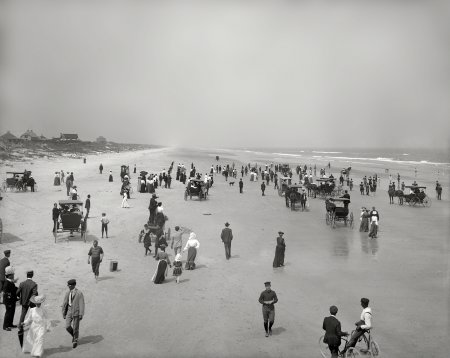
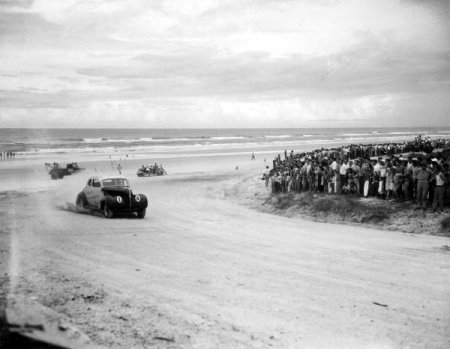

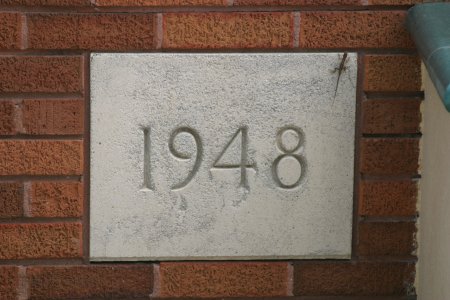

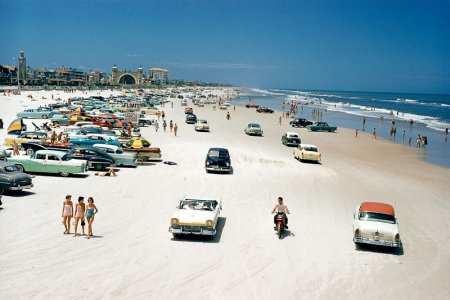
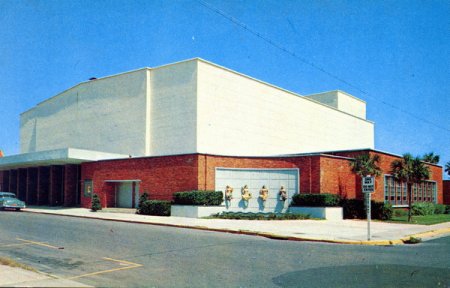
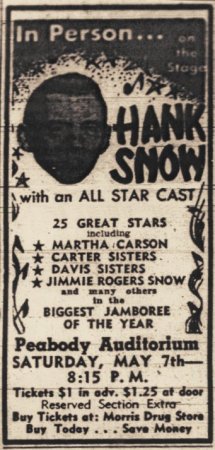
 Elvis, Scotty and Bill played the Peabody Auditorium for the first
time on May 7, 1955 while on a tour with Hank Snow's Jamboree that had
started in
Elvis, Scotty and Bill played the Peabody Auditorium for the first
time on May 7, 1955 while on a tour with Hank Snow's Jamboree that had
started in 